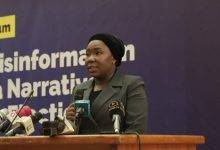The Minimum Dietary Diversity of Women (MDDW) in Ghana is 58.9 per cent, according to the 2020 Comprehensive Food Security and Vulnerability Analysis (CFSVA).
This implied that of the 30 million plus population of Ghana (2021 census), 58.9 per cent of women are not eating balanced or healthy food.
MDDW is an indicator whether or not at least five out of 10 specified food groups are eaten by women aged 15 to 49 years.
The proportion of women aged 15 to 49 who meet the minimum in population can be used as a proxy measure for better adequacy of micronutrients, a significant feature of diet quality.
According to the CFSVA, Northern Region was the region with the highest proportion of women (62.1 per cent) meeting the minimum dietary diversity, that is, eating from at least five food groups a day prior to the survey.
Similarly, the Upper East Region was the region with the least proportion of women (57.2 per cent) aged 15 to 49 who consumed at least five food groups a day prior to the survey.
The survey further revealed that staples, such as cereals and tubers, remain the most consumed food group among Ghanaian women of reproductive age.
Almost all women consumed food made from cereals and tubers prior to the survey and it was followed by meat/poultry/fish and its products.
Milk and milk products, the survey noted, were the least consumed food group, while dark green leafy vegetables, regarded as the rich source of iron, were consumed by 64.3 per cent of women.
Ghana government through the Ministry of Food and Agriculture (MOFA) and Ghana Statistical Service (GSS) in collaboration with the United Nations World Food Programme (WFP) and Food and Agriculture Organisation (FAO) conducted a nationwide Comprehensive Food Security and Vulnerability Analysis for Ghana, in 2020.
CFSVA is a situational analysis on the food security situation in Ghana across all the 261 administrative districts.
It provides a comprehensive and detailed analysis of who the food insecure and vulnerable people are in the country, where they live, how many they are, why they are food insecure/vulnerable and what can be done to save their lives and livelihoods among others.
The analysis were done using indicators and a classification typically adopted by the WFP in their own assessment.
On food insecurity, the CFSVA, indicated that the region with the highest prevalence of food insecurity is Upper East with a rate of 49 per cent, with two other regions-North East and Northern, having food insecurity prevalence rates exceeding 30 percent and 31 per cent respectively.
Food security has been described as a situation in which “all people, at all times, have physical and economic access to sufficient, safe and nutritious food to meet their dietary needs and food preferences for an active and healthy life”.
Earlier in a chat with the Ashanti Regional Director of GSS, Dr Abaka Ansah, said the results of the CFSVA would serve as a benchmark for tracking progress of Sustainable Development Goal (SDG)2, foster better targeting of food and nutrition security and contribute to planning and policy engagement.
The Deputy Country Director of WFP, Anna Mukiibi Bunnya, also indicated that the analysis were done to enable government to investigate explanations of food insecurity outcomes, nationally or regionally as the basis for adapting preventive policy actions that address root causes.
This including monitoring and ‘early warning systems’, enhancement of food and marketing systems, livelihood promotion and infrastructure development.
FROM KINGSLEY E.HOPE, KUMASI







